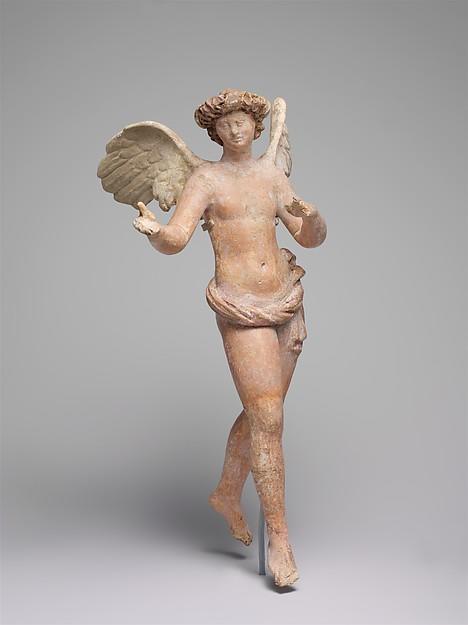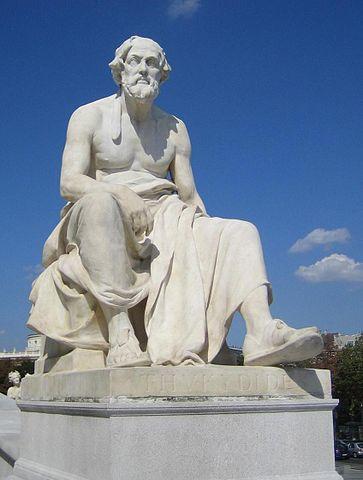The Chosen Exhibit Description
For my reflection essay after visiting the Ancient Greece Architecture Gallery at the Metropolitan Museum of Art, I have chosen one of the ancient Greek pieces of art presented there, namely, the terracotta statuette of Eros flying (see Figure 1) (Karoglou, 2016).

The statuette represents Eros, the Greek god of sexual attraction, wearing a skimpy chlamys (the ancient Greek type of a short cloak) and a thick wreath. The statuette is of the Ionic style and was made in Myrina in approximately 200-150 B.C. during the Hellenistic period, the time when the Greek cultural power and influence were at their peak. The height of the statuette is 25.7 cm (Karoglou, 2016).
Eros is depicted as a winged adolescent youth, a kind that had quite a long history at Myrina from the late third century B.C. The style of this subtly and beautifully executed terracotta reflects the influence of the Pergamene school of sculpture that flourished at the beginning of the second century B.C. in Pergamon, a city that was a center of the kingdom ruled by the Attalid Dynasty (Karoglou, 2016).
Comparison with Similar Examples from the Textbook
The most common materials of which most ancient Greek sculptures were made are terracotta, bronze, and ivory. There are some examples of statuettes made of these materials in the textbook that are similar to those seen at the museum. For instance, there are many pictures of terracotta statuettes, such as terracotta statuettes of a standing woman, of an actor, of a doll with the articulated arms sitting on a chair, and so on. There are also bronze statuettes of similar style and size, such as the bronze statuette of an Ethiopian, of Artemis, of a horse, and so on. Additionally, there are a couple of examples of ivory statuettes.
The Influence of Greek Architecture on Contemporary Works
Ancient Greece is frequently considered the cradle of the western world. Its architecture, art, political thought, and literature have had an influence on western society for thousands of years. In terms of architecture, the influence of Ancient Greece is the most prominent. Greek architects built some of the finest buildings in the entire Ancient World. Even nowadays, some of their structures, such as theaters, stadia, temples, and many distinctive features of their structures are used as a foundation for the construction of modern buildings (Bliangas, 2011).
The ancient Greek architectural styles are Doric, Ionic, and Corinthian. Doric is one of the oldest architectural orders existing today. Its distinct features are a plain roof and vertical columns on the facade. A vivid modern example of this style in the U.S. is Perry’s Victory and International Peace Memorial in Ohio. The Ionic order is more elegant, intricate, and delicate than Doric style. This style was dominant in Ancient Greece during the Hellenistic period. A vivid modern example of this style in the U.S. is the Virginia State Capitol building. The Corinthian style is similar to the Ionic style but more sophisticated and detailed. Vivid modern examples of this style in the U.S. are the U.S. Capitol building and the U.S. Supreme Court building (Bliangas, 2011).
Also, the results of this influence can currently be observed in almost every major city in the U.S. and Europe. It is preserved mostly in small details, such as the facades of buildings, various sculptures, the columns of theaters, and the bas-reliefs of churches. One more example of the influence of ancient Greek architecture is the statue of Thucydides near the Vienna Parliament built-in 1884 (see Figure 2).

Other famous examples of the influence of ancient Greek architecture on modern buildings include the Lincoln Memorial in Washington, D.C., Cambridge University in Cambridge, England, and the Prado Museum in Madrid (Bliangas, 2011).
References
Bliangas, J. (2011). Ancient Greek to modern architecture with Greek influence.
Karoglou, K. (2016). The collection of Greek terracotta figurines at the Metropolitan Museum of Art. Les Carnets de l’ACoSt, 14(3) 6–7.
Statue of Thucydides [Image]. (2016)